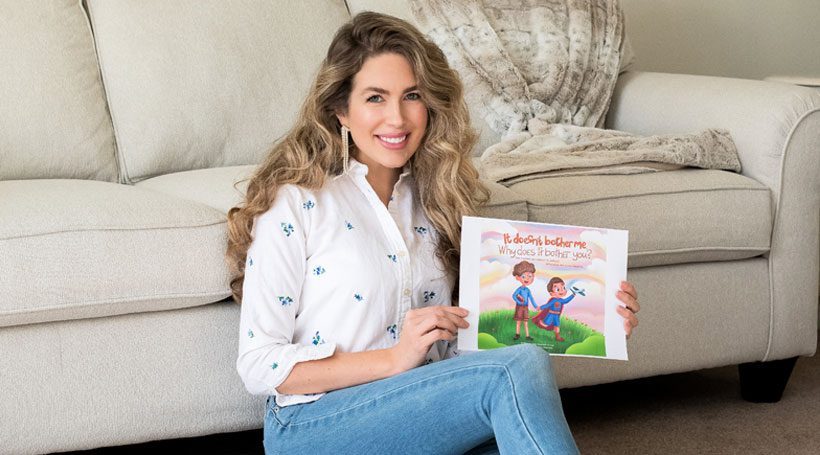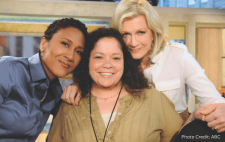As a child, Dana Dewedoff-Carney was almost always smiling. But behind closed doors, she would confide in her mom about classmates who teased her for having an IEP (Individualized Education Plan). As a student who learned differently, she knows how those differences can make a child feel isolated, and she’s seen it happen still today.
So while running 2 businesses and raising 5 children, the Cinnaminson resident decided to help in the best way she knows how: combining creativity and education. Her children’s book, “It doesn’t bother me, why does it bother you?” was released last month. Dewedoff-Carney shared the joys and challenges she faced diving into the world of children’s literature.
Q: When did you decide to write a children’s book?
The book is inspired by my 2 sons and other children I’ve met, and it’s aimed at shifting perceptions and encouraging understanding and the beauty of diversity.
Q: How did you come up with the book’s title?
In the book, there’s a character who compares the 2 boys. That’s based on a parent volunteer who was on a field trip who actually would compare my sons, saying “he’s getting bigger than you.” My younger son is small for his age and my older son is tall for his age, and that didn’t bother my son until people commented on it. So I came up with a mantra that you say to adults and children when they make those comments: “It doesn’t bother me, why does it bother you?”
Q: So this is a cause close to home?
I’ve witnessed firsthand, especially with myself, the impact of comments on children’s differences, even those made by adults. It’s heartbreaking to see a child feel they’re inadequate or misunderstood because of those kinds of comments. I remember confiding in my mom about being teased. But the teachers and staff wouldn’t always notice. They would say, “She’s always so happy and smiling.” Now it’s happening to my children and other parents say their children are experiencing it too. I want to shine a light on these hidden struggles.
Q: Do the boys know there’s a book coming out based on their lives?
My 10-year-old has known about it and is waiting for the book to be finished. He was so excited, and he would even give me constructive criticism along the way. I also had other children read the book, between the ages 8 and 15. I wanted to make sure it was relatable and accurate.
Q: What can people expect to find in the book?
I consulted with different mental health professionals. I asked them different questions to get input into what other children struggle with. There’s a character named Ethan, he has a stutter. I describe his words like playing a game of hide and seek. And there’s Lucas who has ADD. I compare his thoughts to Legos, each one needs to be placed just right for it to click. And Jake struggles with anxiety. Despite his smile and demeanor, he grapples with worries and fears. He finds himself pacing and seeking solitude, but he still wants to be included like everyone else.
Q: How did you find an illustrator?
I had to do a lot of Google searches and looked on Etsy, and the person who I found lives on the other side of the world. So I’ll be up at like 2:30 am talking to them, making tweaks. It was a challenge to find the right person, because you want to find an illustrator who is able to convey the messaging through that art. It has to be the right fit. I went through about 7 illustrators. It wasn’t that their work wasn’t good, it just wasn’t the right fit. It wasn’t congruent with the story.
Q: How did you know you had the right fit?
The character Lucas has ADD and in one scene he looks really upset when his classmates and the teachers are telling him to just focus. So the expression on his face had to be just right, needed to be accurate for him. That’s going to help children who go through that to feel accepted and understood, but also to help teach their friends that this reaction is alright.
Q: Did you run into any challenges while writing?
There were people who raised questions about the book labeling children. They said, “Since this is inspired by your sons, are you labeling them? Are they going to feel insecure?” I said no. Because, ultimately, my goal is to help them feel empowered about their differences. Because everyone belongs in the classroom and it’s going to help them feel empowered, going to allow them to be more empathetic to their friends and more inclusive as a result.
Q: What do you want people to get out of the book?
I hope the book can be a resource in schools, and for parents to buy for their children – whether their child is the one doing the bullying or they’re the one being bullied. There’s so much that happens in our formative years, and if we can work on these things now, teach our children now and change how we talk about a lot of these differences, then we can help children feel more understood. It will help them later in life. We’re giving them tools and resources that will help them when they’re adults.
Q: Is there more writing in your future?
I’m working on another book, for grades 0 to 6. It’s called “Sammy’s Sleeping Trip Adventures.” It’s a sensory-friendly book, and it was inspired by my son who calls going to sleep and falling into his dreams sleeping trips.















